|
|
|
Sort Order |
|
|
|
Items / Page
|
|
|
|
|
|
|
| Srl | Item |
| 1 |
ID:
137787


|
|
|
|
|
| Summary/Abstract |
One of the goals of peacekeeping operations is limiting the amount of violence that takes place during a civil war. However, peacekeeping forces cannot occupy every part of a country that is engulfed in a civil conflict. This raises the question as to where peacekeeping forces decide to go once they are deployed to a civil war-torn country. In this article, we contribute to the burgeoning research that examines peacekeeping at the microlevel by attempting to determine whether peacekeeping operations go to those areas that are in most need of their help. Utilizing geocoded data from the UCDP GED and PKOLED projects, we use spatial analysis techniques to create kernel density estimates of civil war violence and peacekeeping operations at site-specific locations. We then use these newly generated variables in a variety of regression models to determine whether the location of civil war battles influences the location of peacekeepers. The analysis confirms our expectations in that the location of violence significantly predicts the location of peacekeeping operations, but only after these operations have been in a civil war-torn country for a considerable length of time. Contrary to our expectations, however, peacekeeping operations do not seem more adept at identifying and responding to government and rebel violence relative to attacks against civilians
|
|
|
|
|
|
|
|
|
|
|
|
|
|
|
|
| 2 |
ID:
137750
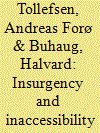

|
|
|
|
|
| Summary/Abstract |
A widely held belief within policy and practice contends that rough terrain and other physical obstacles to power projection hinder public surveillance, lower counterinsurgency capability, and generally constitute an important facilitator of rebellion. Likewise, sociocultural exclusion and alienation from the core are widely assumed to increase latent conflict risk through their influence on identity formation and perception of collective grievances. However, there is no scientific consensus on the empirical strength or significance of such a relationship, and many quantitative studies fail to find a robust link between a country's geographical or ethno-demographic characteristics and its estimated conflict risk. This paper represents a first comprehensive evaluation of how physical and sociocultural inaccessibility relate to contemporary civil wars. Drawing on recent advances in geographic information systems and georeferenced indicators of terrain, settlement patterns, ethno-political status, and armed conflict, we put the purported causal relationship to empirical test. A statistical analysis of civil-conflict events across post-Cold War Africa gives considerable support to the proposed theoretical framework, revealing that the various dimensions of inaccessibility all exert significant and substantive effects on local conflict risk. We find weaker evidence for the notion of substitutability; the inaccessibility indicators largely retain their individual effects when included in the same regression model.
|
|
|
|
|
|
|
|
|
|
|
|
|
|
|
|
| 3 |
ID:
137788


|
|
|
|
|
| Summary/Abstract |
A rich literature has developed focusing on the efficacy of peacekeeping operations (PKOs) in a temporal sense—asking whether the periods following a deployment are more peaceful or not. We know less about the efficacy of PKOs in a spatial sense. Can peacekeeping shape the geographic dispersion of particular episodes of violence? We posit that PKOs can contain conflict by decreasing the tactical advantage of mobility for the rebels, by obstructing the movement of armed actors, and by altering the ability for governments to seek and confront rebel actors. We investigate the observable implications using georeferenced conflict polygons from the Uppsala Conflict Data Program's (UCDP) Georeferenced Event Dataset (GED). Our findings confirm that PKOs tend to decrease movement in the conflict polygons, especially when robust forces are deployed and when rebel groups have strong ethnic ties. Our findings, on the one hand, imply that PKOs reduce the geographic scope of violence. On the other hand, PKOs may allow nonstate actors to gain strength and legitimacy and thus constitute an even greater future threat to the state whether some form of accord is not reached.
|
|
|
|
|
|
|
|
|
|
|
|
|
|
|
|
| 4 |
ID:
137786
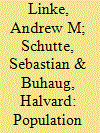

|
|
|
|
|
| Summary/Abstract |
One of the most powerful predictors of violent political conflict is proximate violence in space and time. This spatiotemporal pattern has been identified between countries as well as within them. What explains this clustering is less clear, and different studies point to different mechanisms. Focusing on sub-Saharan African states, we examine whether population attitudes may contribute to the spread of political violence at subnational scales. In a quasi-experimental research design—using georeferenced survey data of 18,508 respondents for 162 administrative units across 16 countries, paired with precisely georeferenced conflict event data—we find that popular acceptance of (the legitimacy of) the use of physical violence is positively associated with subsequent conflict events. Furthermore, the combined effect of nearby violence and approval of violence is stronger than either condition alone, implying a diffusion effect. While we find some evidence that conflict events affect later public opinion, our final models control for violence that occurred before the survey data were gathered. The fact that we include such violence in our analysis suggests that the reported results cannot be dismissed as merely reflecting a reverse causal relationship.
|
|
|
|
|
|
|
|
|
|
|
|
|
|
|
|
| 5 |
ID:
137791
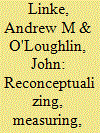

|
|
|
|
|
| Summary/Abstract |
How does political violence affect the attitudes and beliefs of affected populations? This question remains of central concern to the discipline of conflict studies. In response, we make the case (by empirical example) that the choice of spatial and temporal ranges of analysis influences conclusions about the associations between exposure to political conflict and subsequent opinions. Using 2005 survey data from Russia's North Caucasus and georeferenced conflict data for the preceding 2 years, we find that violence affects levels of ethnic pride, trust in public institutions, and preferences for ethno-territorial separation, as well as other postwar attitudes. By designating a wide range of distance and time boundaries for capturing a conflict/attitude relationship, we argue for a more inductive style of analyzing theoretical propositions than is usually found in the field of conflict research. Our research is framed within the theoretical and empirical discussions of contextual-, neighborhood-, and community-level drivers of individual-level outcomes from the political geography and conflict studies literatures.
|
|
|
|
|
|
|
|
|
|
|
|
|
|
|
|
| 6 |
ID:
137748
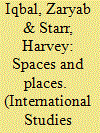

|
|
|
|
|
| Summary/Abstract |
The selection of our theme for the International Studies Association's 2014 convention, “Spaces and Places: Geopolitics in an Era of Globalization,” was motivated by the need to indicate, and help to remedy, an imbalance in the intellectual attention devoted to time versus space and to raise the consciousness of scholars across international studies to the relevance of spatiality in its many forms. International relations scholars are keenly aware of the role that temporal dynamics play in international politics, and the influence of temporality is acknowledged in works adhering to a range of methodological traditions. It is important, however, both in refining extant theories of global politics and in developing new theories from evolving realities, to be attentive to the contexts of those theories and the phenomena to which they pertain. Thus, world politics must be contextualized not only in time (across history) but also across space.
|
|
|
|
|
|
|
|
|
|
|
|
|
|
|
|
| 7 |
ID:
137789
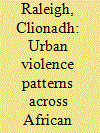

|
|
|
|
|
| Summary/Abstract |
This analysis of urban political violence across Africa considers why the proportion and frequency of conflict is increasing in urban areas while decreasing in rural areas. The decline of formally organized violence in predominantly rural areas, and the increase of more variegated forms of political opposition and conflict in urban zones, is interrogated through demographic and grievance-based explanations. Urban violence displays a range of agents, goals, intensities, and triggers and is alternatively regarded as a response to the lack of capacity and poor governance found in urban contexts, or to the changing demographic and political character of African states. Yet, the multiple, low-intensity forms of urban violence present—including militia attacks, communal contests, riots, and protests—indicate a change in the collective action capabilities and goals of modern conflict agents. These goals are themselves shaped by the experience of mounting urban grievances, but the ethnic and regional heterogeneity in urban areas prevents substantial collective action to counter the urban marginalization practiced by many African governments. Despite the low-intensity nature of urban threats, this compounded violence is a substantial security threat across developing states and is leading to the rise of the “fragile city.”
|
|
|
|
|
|
|
|
|
|
|
|
|
|
|
|
|
|
|
|
|